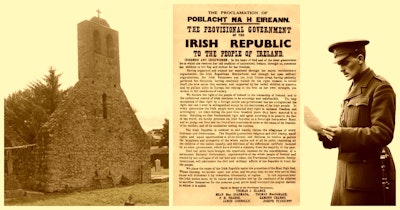19th century etching of the Battle of Kilrush
On April 15th 1642, on the road between Athy and Dublin, two opposing armies faced off at Kilrush, Kildare. The ensuing battle between Irish Catholic Rebel Confederates and Protestant Royalist forces left more than 500 dead.
Have you listened to our podcast? Get the latest on our Episode Page.
The Royalist forces were commanded by James Butler, 1st Duke of Ormond (1610–1688). Irish Royalists supported Charles I, King of England, likely motivated by a desire to maintain the status quo of their landholding position.

Richard Butler, 3rd Viscount Mountgarret (1578–1652) and cousin of Ormond, led the Confederates who were fighting for a restoration of Catholic position and lands lost as a result of Nine Years War some 50 years prior.
The opposing forces met in Kilrush, a townland, 7 miles North East of Athy. Ormond was attempting to return to his Dublin base after a 10 day foray designed to reinforce Midlands' Royalist garrisons. Mountgarret commanded the larger of the 2 forces estimated at 8,000 infantry and 400 cavalry. He aimed to cut off Ormond’s retreat to Dublin whose forces were likely half the size, however Mountgarret’s forces were comprised of militia lacking the experience of the Royalists.

Although Mountgarret managed to choose the battle site by intercepting Ormond’s smaller force, his left wing collapsed under a cavalry charge which proved decisive. The Royalists claimed to lose only 20 men while attributing more than 500 Confederate casualties.
Ormond returned victorious to Dublin and received a jewel valued at £500 as a reward for his victory. Mountgarret survived the clash at Kilrush and would continue to participate in a war which was marked by shifting alliances ultimately culminating with the infamous Cromwellian invasion of 1649 - 1653.
Kilrush was one of many battles that took place in the course of a war whose name is disputed. Some refer to the conflict as The Eleven Years' War others The Irish Confederate Wars, what is unquestioned is the swathe of destruction cut across Ireland leaving a conservatively estimated 200,000 dead. All this on island where the population was thought to be 1.5 million at the outbreak of hostilities. While the death toll was calamitous, so too was the impact on Gaelic Ireland which was crushed by dispossession as a result of the Cromwellian Plantation.

















